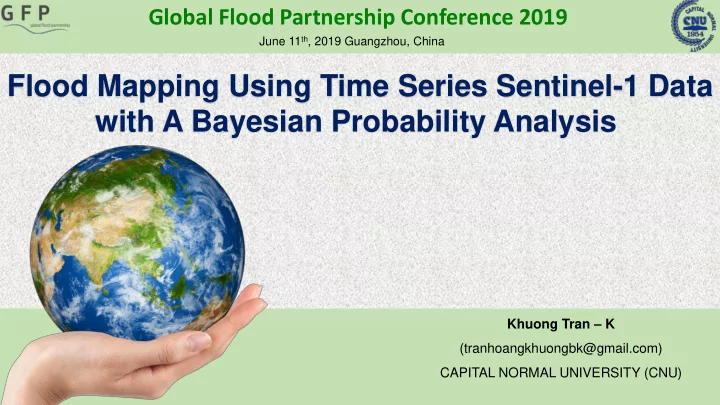

Global Flood Partnership Conference 2019 June 11 th , 2019 Guangzhou, China Flood Mapping Using Time Series Sentinel-1 Data with A Bayesian Probability Analysis Khuong Tran – K (tranhoangkhuongbk@gmail.com) CAPITAL NORMAL UNIVERSITY (CNU)
Contents 1. Study Area 2. Flood 3. Flood Mapping
1. Study Area Vietnam Area 331,210 km 2 97 million people GDP grew at 7% 2018 Dynamic market 6 th affected by climate change ( Germanwatch eV 2019 ) VN Mekong Delta
1. Study Area Vietnam Mekong Delta key economic region, Diversity 40,500 km 2 ; 17.3 million inhabitants “rice bowl of Asia" ( M. Garschagen et al 2012 ) fruits; fisheries and aquaculture Rice filed Fish harvesting Shrimp harvesting Fruit float market
1. Study Area Vietnam Mekong Delta Climate change - flood, drought, typhoon, landslide, subsidence, saline intrusion, sea level rise, migration and other issues. Drought Typhoon Landslide Sea level rise
2. Flood Floods in Vietnam Mekong Delta Annual Usual period: June – December Highest flood peak is around 4m – 5m Becoming serious, destructive and unpredictable
2. Flood Floods in Vietnam Mekong Delta Historical flood in 2000 • Highest peak 5.06m at Tan Chau station ( Vietnam Academy for Water Resources, 2011 ) • 539 deaths (over 300 are children), 212 injured, half a million people have emergency relief • 890,000 houses, 224,508 ha of rice were flooded, 86,000 ha of damaged crops • Total destruction estimated ~ 200 million USD Flood in 2018 • Highest peak 4.09 at Tan Chau station • Over 2000 ha rice field were flooded completely • Many loses about people and property.
3. Flood Mapping 3.1 Data Mapping and monitoring floods is extremely important mission • Quick; cost-effective; accurate • Overcome the weather conditions (Cloud, rain). • Radar data >< Optical data resources. Sentinel - 1 data • All weather • high spatial resolution • short-revisit time • Free
3. Flood Mapping 3.2 Flood event in Vietnam Mekong Delta • Between Dry season and Flood season in 2017
3. Flood Mapping 3.3 Issues 3.3.1 Submerged vegetation The double-bounce interactions occurs when the radar signal penetrates through the vegetation and reaches the water surface. ( Plank et al. 2017; Tsyganskaya et al. 2018 ). Increase significantly backscatter intensities and induce the errors in delineation. ( Plank et al. 2017; Tsyganskaya et al. 2018 ).
3. Flood Mapping 3.3 Issues 3.3.2 Temporary open water An increase and decrease in the backscatter values occurring in the flood duration ( Tsitsi Bangiraa et al. 2018 ). 3.3.3 Low land-water contrast Low contrast between land-water at the reservoirs occur in the rainy season and in the dry season. It also creates the change in backscatter intensities ( Dirk Eilander et al. 2014 ).
3. Flood Mapping 3.4 Goals Temporary Time series OW Backscatter Flood map Submerged Variation, vegetation Higher accuracy Errors in delineation Polarizations Low-contrast
Global Flood Partnership Conference 2019 June 11 th , 2019 Guangzhou, China Khuong Tran (tranhoangkhuongbk@gmail.com)
Recommend
More recommend